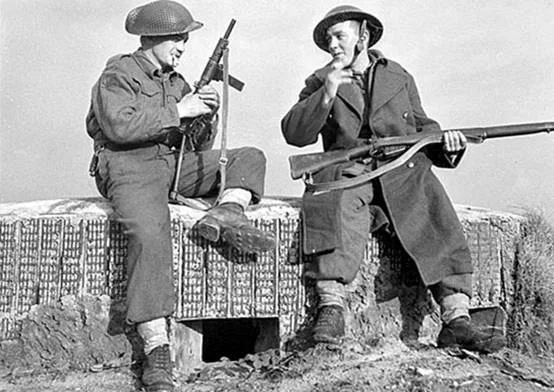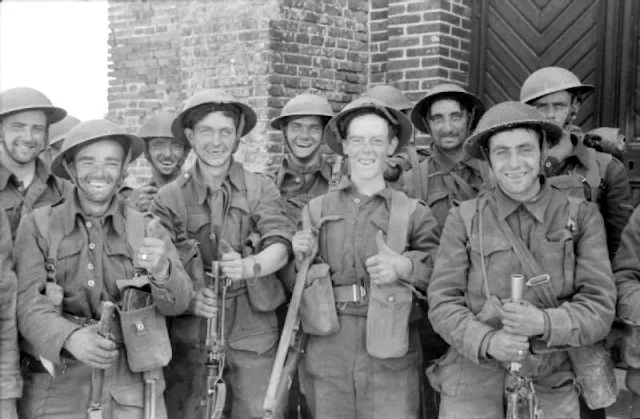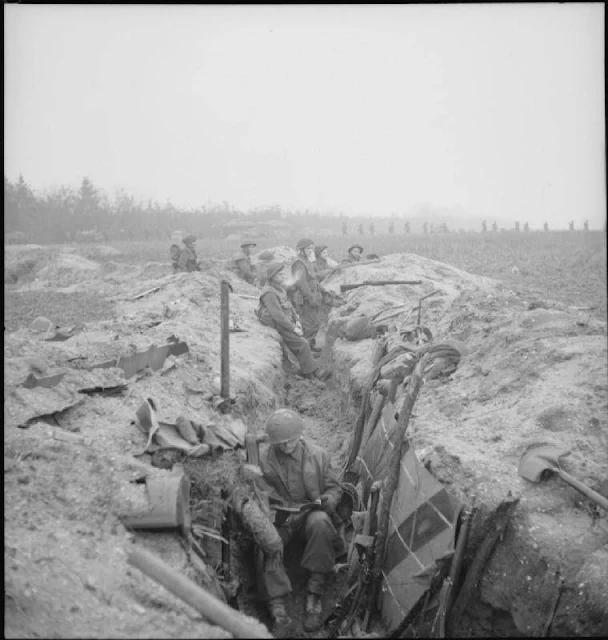 |
| Infantrymen of "B" Company, The Argyll and Sutherland Highlanders of Canada riding in a German captured truck with German prisoners at Saint-Lambert-sur-Dives, France on 19 August 1944. |
Details from the regiment were called out on service before the actual start of the war on 26 August 1939 and placed on active service on 1 September 1939 as The Argyll and Sutherland Highlanders (Princess Louise's) (Machine Gun), CASF (Details), for local protection duties.
The details were formed as a battalion and designated The Argyll and Sutherland Highlanders (Princess Louise's), CASF on 15 August 1940. It was redesignated the 1st Battalion, The Argyll and Sutherland Highlanders (Princess Louise's) (Machine Gun), CASF on 7 November 1940 and then the 1st Battalion, The Argyll and Sutherland Highlanders (Princess Louise's), CASF on 1 February 1941. It served in Jamaica on garrison duty from 10 September 1941 to 20 May 1943, and embarked for Great Britain on 21 July 1943. On 26 July 1944, it landed in France as part of the 10th Canadian Infantry Brigade, 4th Canadian Armoured Division, and it continued to fight in North West Europe until the end of the war. The overseas battalion was disbanded on 15 February 1946.
The Argylls mobilized a battalion for the Canadian Active Service Force in June 1940. Prior to this, there were occasional call outs. Beginning in August 1939, Argylls performed guard duty on the local canal and electrical facility, for example. The problems of active duty were myriad. First World War pattern tunics and the kilt were issued until modern Battle Dress was issued, Ross rifles were the only weapons, and hollow pipes and bricks comprised heavy weapons for the mortar platoon.
Niagara
The first months of the war were spent in and around Niagara-on-the-Lake, a dreary round of guard duty on the Welland Canal and local power facilities. There was little training and almost no new equipment. The first Bren light machine guns, for example, arrived in December 1940. But there was time for setting the foundations for excellent administration and for addressing the usual range of problems associated with turning civilians into soldiers. It was during this period that the notorious "Mad Five" went AWOL, made their way to the Sunnyside Amusement Park in Toronto and telegraphed the CO – "Having a great time. Wish you were here." In May 1941 the 1st Battalion entrained for Nanaimo, BC, where it underwent several tedious months of route marches alternating with inspections.
Jamaica
September 1941 to May 1943 brought a sojourn in the sun – garrison duty in Jamaica. During this period, the reality of war was brought home by the fate of the Winnipeg Grenadiers (which unit the Argylls replaced in Jamaica) in Hong Kong, and of the Royal Hamilton Light Infantry (a sister unit from Hamilton) at Dieppe. Under the command of Lieutenant-Colonel Ian Sinclair, the unit received new weapons and modern equipment, improved its administration, and began a complete program of small unit tactics, fitness, and training.
England
The men of the 1st Battalion returned to Hamilton in May 1943. In preparation for overseas service, it received a new CO and senior officers, and many warrant officers and NCOs were also replaced. A notable exception was the Regimental Sergeant Major, Peter Caithness McGinlay. By August 1943 the unit had moved to England and joined the 10th Brigade of the 4th Canadian (Armoured) Division. Acting Sergeant John Rennie won a posthumous George Cross in October 1943, dying while shielding others from an exploding grenade during training. Collective training, specialized courses for individuals, and schemes at battalion, brigade and divisional level occupied the unit, now under the command of Lieutenant-Colonel J. David Stewart for whom the Argylls' reported a genuine affection. In action, he was described as having an intuitive sense of battle (which could not be taught), cool imperturbability, and a refusal to fight according to preconceived notions.
Normandy
The unit's first battles in early August 1944 were small successes fought along the road to Falaise. The first major action, Hill 195 on 10 August, was an unorthodox success; Stewart led the battalion single file through the darkness of night and German lines to capture this hitherto unassailable strong point. It was an act which historian John A. English has called "the single most impressive action of Operation Totalize." Less than ten days later in the Falaise Gap, a battle group of "B" and "C" companies of the Argylls, and a squadron of South Alberta Regiment tanks captured St Lambert-sur-Dives and held it for three days against desperate counterattacks. The action resulted in Major David Vivian Currie of the South Albertas being awarded the Victoria Cross.
Of the experience of battle, Cpl H. E. Carter wrote to his mother on 13 August:
"That life in the front is not fun, not glamorous — it's dirty, and fierce and anyone that says they're not scared is crazy. But I'm not going to talk much about that. We try and keep our spirits up, joke and enjoy yourself under fire and we do an exceptionally good job of it." That very same day Capt Mac Smith put it best when he wrote to his wife: "The men are simply wonderful. They have done well, and are getting better. They grumble . . . and dig, and advance and dig, and advance. They stand shelling mortaring and occasional bombing, and then stand up in their trenches and ask where the hell the food is."
The Scheldt
The Rhineland
Closing Phases
Friesoythe
Canadian Army Historian C.P. Stacey commented that the only time he saw what could be considered a war crime committed by Canadian soldiers was after the very popular Commanding Officer of the Argylls, Lieutenant-Colonel F.E. Wigle, was shot dead during the battle of Friesoythe on 14 April 1945, allegedly by a German civilian. Col. Wigle was in fact killed by a German paratrooper at his tactical headquarters located south of Friesoythe.
"Apparently a rumor was going round that Colonel Wigle had been killed by a civilian sniper; as a result a great part of the town of Friesoythe was set on fire in a mistaken reprisal. This unfortunate episode only came to my notice and thus got into the pages of history because I was in Friesoythe at the time and saw people being turned out of their houses and the houses burned. How painfully easy it is for the business of "reprisals" to get out of hand!"
As a result, Friesoythe was almost totally destroyed or, as G.L. Cassidy put it, "The raging Highlanders cleared the remainder of that town as no town has been cleared for centuries, we venture to say." One German source estimates that 300 of 355 houses were totally destroyed, for a percentage rate of 84.5. Another source, the Brockhaus Enzyklopaedie, estimated the destruction as high as 90%. The incident is also recounted in Tony Foster's Meeting of Generals.
Overall
Through Moerbrugge, the Scheldt, Kapelsche Veer, and the Hochwald Gap to Friesoythe, the Küsten Canal, and Bad Zwischenahn, the Argylls were successful against the enemy – but there was more. Their losses (267 killed and 808 wounded) were the lowest in the 10th Brigade and their successes constant. Cynicism is a soldier's rightful lot and the Argylls' never lost it. Self-satisfaction came with, and was sustained only by, success – a success sustained despite the successive wholesale turnovers in the rifle companies. Neither quality was lost during ten months of battle. It made them as Capt Claude Bissell once remarked "a happy regiment and a formidable one in action."
The 1st Battalion provided the headquarters and one rifle company for the Canadian Berlin Battalion, a composite battalion which represented the Canadian Armed Forces in the British victory celebrations in Berlin in July 1945. The battalion returned to Hamilton in January 1946 where it was dismissed.
Lineage
The Argyll and Sutherland Highlanders of Canada (Princess Louise's)
Originated 1 September 1903 as the 91st "Highlanders"
Redesignated 2 July 1904 as the 91st Regiment Canadian Highlanders'
Redesignated 1 May 1920 as The Argyll and Sutherland Highlanders of Canada'
Redesignated 15 October 1920 as the Princess Louise's (Argyll and Sutherland Highlanders) of Canada
Redesignated 15 June 1927 as The Argyll and Sutherland Highlanders of Canada (Princess Louise's)
Amalgamated 15 December 1936 with the 3rd Machine Gun Battalion, CMGC (less 'C Company') and redesignated as The Argyll and Sutherland Highlanders of Canada (Princess Louise's) (Machine Gun)
Redesignated 7 November 1940 as the 2nd (Reserve) Battalion, The Argyll and Sutherland Highlanders of Canada (Princess Louise's)
Redesignated 1 February 1941 as the 2nd (Reserve) Battalion, The Argyll and Sutherland Highlanders of Canada (Princess Louise's)
Redesignated 15 February 1946 as The Argyll and Sutherland Highlanders of Canada (Princess Louise's)
3rd Machine Gun Battalion, CMGC
Originated 1 June 1919 as the 3rd Machine Gun Brigade, CMGC
Redesignated 15 September 1924 as the 3rd Machine Gun Battalion, CMGC
Amalgamated 15 December 1936 (less C Company) with The Argyll and Sutherland Highlanders of Canada (Princess Louise's)
Battle Honors
Falaise
Falaise Road
St. Lambert-sur-Dives
The Seine, 1944
Moerbrugge
The Scheldt
Breskens Pocket
The Lower Maas
Kapelsche Veer
The Rhineland
The Hochwald
Veen
Friesoythe
Küsten Canal
Bad Zwischenahn
North-West Europe, 1944–1945
Alliances
United Kingdom – The Argyll and Sutherland Highlanders (5 SCOTS)
Australia – The Royal New South Wales Regiment
Pakistan – 1st Battalion (Scinde), The Frontier Force Regiment
Further Reading
It Can't Last Forever: The 19th Battalion and the Canadian Corps in the First World War by David Campbell (2016)
Black Yesterdays: The Argylls' War by Dr. Robert L. Fraser (1996)
The Argyll and Sutherland Highlanders of Canada [Princess Louise's] 1928–1953 by Lieut. Colonel H. M. Jackson (1953)
Historical Records of the Argyll and Sutherland Highlanders of Canada (Princess Louise's), Formerly 91st Regiment... by Lieut.-Col. Walter H., Turnbull, Lieut.-Col. William R., and Chrisholm, LI Bruce (1928)
 |
| Cap Badge and collar badges of the Argyll & Sutherland Highlanders of Canada |
 |
| Travels of the 1st Battalion. |
 |
| The Argyll & Sutherland Highlanders of Canada in Jamaica. |
 |
| Taking part in a Combined Operations training exercise at Inveraray, Scotland. |
 |
| A soldier of the Argyll and Sutherland Highlanders of Canada runs forward past a burning Sherman tank in the village street, St. Lambert-sur-Dives, August 1944. |
 |
| German 28cm railway gun of the Heeres-Eisenbahn Artillerie Abteilung 702, taken by the Argyll and Sutherland Highlanders of Canada at Sluiskil and photographed in Eeklo railway station. |
 |
| Argyll and Sutherland Highlanders of Canada cooking a meal and warming themselves around a fire. |
 |
| Children at the Christmas party sponsored by the Argyll and Sutherland Highlanders of Canada, Elshout, Netherlands, 19 December 1944. |
 |
| 1st Battalion in Northwest Europe 1944-1945. |
 |
| Argyll and Sutherland Highlanders of Canada having dinner in a barnyard near Veen, Germany, 7 March 1945. |
 |
| Argyll & Sutherland Highlanders line up for rations in Veen, Germany, 7 March 1945. |
 |
| An Argylls’ PIAT team, Meppen, Germany, 8 April 1945. |
 |
| Theatre of Operations from Rhine Crossing to V-E Day. |
 |
| Argyll and Sutherland Highlanders of Canada aboard a Kangaroo armored personnel carrier, 11 April 1945. |
 |
| The Parade before the Column of Victory, 25 July 1945. |
 |
| The pipes and drums of The Argyll and Sutherland Highlanders of Canada (Princess Louise's), which accompanied the Canadian Berlin Battalion, on parade before the Column of Victory, 25 July 1945. |

































